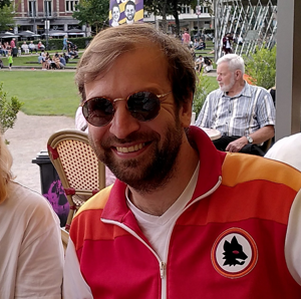Browsers are more powerful than ever! Non-browser software can be compiled to WebAssembly and used client-side. WebAssembly or 'WASM' acts as a bridge, allowing code written in languages like Rust, C, and C++ to execute smoothly in the browser.
In my SuperMap.world side-project I'm using D3 to generatively create lots of map designs in PNG and SVG formats. To up the challenge, I've been considering adding map animations using d3-transition.

The only problem is compiling video can be a pretty heavy operation (certainly for servers on a side-project budget). Thanks to WebAssembly, we can now get those lazy freeloading clients to do some of the work.
To tip my toe in the water, I've been experimenting with Resvg and FFmpeg (compiled to WASM) to see if I can capture D3.js transitions and render them out to Gif, MP4, or whatever format – no servers required!
Before you ask – yes, I know that rendering to Webcanvas in a raster format then capturing with FFmpeg makes more sense but I have my reasons which I cannot be bothered to explain right now.
Capturing PNG with Resvg
Resvg is a powerful tool for rendering and working with SVGs. I've been using Resvg to convert SVG to PNG from the command line and it does a great job. The plan here is to use it to capture frames that will eventually be compiled into a video.
If you want to try it out on its own all you need to do is import and write a capture function e.g.
<script src="https://unpkg.com/@resvg/resvg-wasm"></script>async function captureSvg() {
// Initialize Resvg WASM
await resvg.initWasm(
fetch('https://unpkg.com/@resvg/resvg-wasm/index_bg.wasm')
);
// Get the SVG element and convert to string
const svgElement = document.getElementById('mySvg');
const svgString = new XMLSerializer().serializeToString(svgElement);
// Create Resvg instance
const resvgJS = new resvg.Resvg(svgString);
// Render to PNG
const pngData = resvgJS.render();
const pngBuffer = pngData.asPng();
// Create blob and download link
const blob = new Blob([pngBuffer], { type: 'image/png' });
const url = URL.createObjectURL(blob);
// Create download link
const a = document.createElement('a');
a.href = url;
a.download = 'capture.png';
a.textContent = 'Download PNG';
document.body.appendChild(a);
}As you'll see above it goes and fetches a .wasm file. Sometimes these files can be quite large – FFmpeg is about 30MB!
In the above example we get a PNG version of the SVG and a download link. We don't want to download a single PNG, but the above is a concise SVG to PNG convert function (NB if you want text rendered correctly you'll need to hand that to Resvg).
Combining D3 + Resvg + FFmpeg
What we want to do is a little different: capture a PNG every time something changes, (e.g. inside a D3 tween function), hand that PNG over to FFmpeg to use as a frame in the video. Once we're done animating we compile and offer the MP4 up for download.

This example animates a simple SVG circle and captures each frame. Here's the code for this example (available on Glitch):
<!DOCTYPE html>
<html>
<head>
<script src="https://d3js.org/d3.v7.min.js"></script>
<script src="https://unpkg.com/@resvg/resvg-wasm"></script>
<script src="./assets/ffmpeg/package/dist/umd/ffmpeg.js"></script>
<script src="./assets/util/package/dist/umd/index.js"></script>
</head>
<body>
<svg id="animation" width="400" height="200"></svg>
<script>
const { FFmpeg } = FFmpegWASM;
// Setup constants and initialization
const FRAME_RATE = 12;
let ffmpeg = null;
// Initialize capture system
async function initCapture() {
// Initialize Resvg
await resvg.initWasm(fetch('https://unpkg.com/@resvg/resvg-wasm/index_bg.wasm'));
// Initialize FFmpeg
const ffmpeg = new FFmpeg();
ffmpeg.on("log", ({ message }) => {
console.log(message);
})
ffmpeg.on("progress", ({ progress }) => {
console.log(`${progress * 100} %`);
});
console.log("Loading ffmpeg wasm")
await ffmpeg.load({
wasmURL: "https://cdn.glitch.me/4877c24f-4232-45d4-9767-d4c67608b8ed/ffmpeg-core.wasm?v=1730219929011",
coreURL: "https://creating-with-data.glitch.me/connecting-atlantic-ani/assets/core/package/dist/umd/ffmpeg-core.js"
});
console.log("Done.")
return ffmpeg;
}
// Frame capture function
let frameCount = 0;
let captureQueue = Promise.resolve();
async function captureFrame(svgString) {
captureQueue = captureQueue.then(async () => {
const resvgJS = new resvg.Resvg(svgString);
const pngData = resvgJS.render();
const pngBuffer = pngData.asPng();
const filename = `frame_${frameCount.toString().padStart(5, '0')}.png`;
console.log(`Capturing ${filename}`)
await ffmpeg.writeFile(filename, pngBuffer);
frameCount++;
});
return captureQueue;
}
// Animation with capture
async function animateAndCapture() {
ffmpeg = await initCapture();
// Setup SVG
const svg = d3.select("#animation");
const circle = svg.append("circle")
.attr("cx", 50)
.attr("cy", 100)
.attr("r", 20)
.style("fill", "blue");
// Create transition
const duration = 2000; // 2 seconds
await circle.transition()
.duration(duration)
.attr("cx", 350)
.style("fill", "red")
.tween("capture", () => {
return async (t) => {
// Get current state of SVG
const svgString = new XMLSerializer()
.serializeToString(svg.node());
await captureFrame(svgString);
};
})
.end(); // Wait for transition to complete
// Create video from frames
await createVideo(ffmpeg);
}
// Create video from captured frames
async function createVideo(ffmpeg) {
await ffmpeg.exec([
'-framerate', FRAME_RATE.toString(),
'-i', 'frame_%05d.png',
'-c:v', 'libx264',
'-pix_fmt', 'yuv420p',
'output.mp4'
]);
// Create download link
const data = await ffmpeg.readFile('output.mp4');
const videoBlob = new Blob([data.buffer], { type: 'video/mp4' });
const videoUrl = URL.createObjectURL(videoBlob);
const downloadLink = document.createElement('a');
downloadLink.href = videoUrl;
downloadLink.download = 'animation.mp4';
downloadLink.textContent = 'Download Animation';
document.body.appendChild(downloadLink);
}
// Start animation when page loads
document.addEventListener('DOMContentLoaded', animateAndCapture);
</script>
</body>
</html>Result
The capture queue
The real magic here happens in the captureFrame function. We want to write multiple frames to FFmpeg's internal file handler, as a sequentially numbered file (e.g., frame_00000.png, frame_00001.png).
We use captureQueue to manage asynchronous frame capturing. Chaining frames in a promise queue ensures each frame finishes processing before moving to the next.
This approach resolved an issue where D3’s tween function wasn’t running synchronously, leading to duplicated or misordered frames.
// Frame capture function
let frameCount = 0;
let captureQueue = Promise.resolve();
async function captureFrame(svgString) {
captureQueue = captureQueue.then(async () => {
const resvgJS = new resvg.Resvg(svgString);
const pngData = resvgJS.render();
const pngBuffer = pngData.asPng();
const filename = `frame_${frameCount.toString().padStart(5, '0')}.png`;
console.log(`Capturing ${filename}`)
await ffmpeg.writeFile(filename, pngBuffer);
frameCount++;
});
return captureQueue;
}
Using captureFrame is simple. We just call it whenever we want to add a frame, such as in a d3 tween function.
Frame rates
When it comes to D3, it's not possible to dictate frame rate. From what I understand, D3 will aim to go as fast as supported by your browser. That's not always possible if you have complex transitions going on. As a result, the frame rate you tell FFmpeg to use may not match what's happening in the browser. I imagine you could track your animation's FPS yourself and pass that to over to FFmpeg at compile time.
The GIF I rendered of the transatlantic cable visualisation has a lot more going on than the circle animation. It came out at about 6 or 7 FPS. That's fine for a GIF but not what you'd want from a "real" video.

Since these transitions use an interpolator I was able to render higher FPS videos by dropping D3 tweens in favour of just capturing renders inside a for loop –
// Use this ...
const framesPerMillisecond = FRAME_RATE / 1000;
const frames = positionDuration * framesPerMillisecond;
for (let i = 0; i < frames; i++) {
positionTween(i / frames, ip, sphere, land);
}
//Instead of ...
d3.transition().duration(positionDuration).tween("render", () => {
return t => {
positionTween(t, ip, sphere, land);
}
}).end();While my browser wasn't able to keep up (i.e. we can't watch the nice animation) it does succesfully produce a smoother video!

